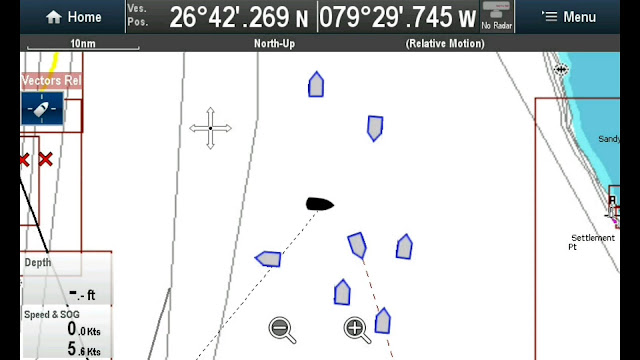We couldn’t get
a consensus on whose fault it was; the guys sided with me and the women sided
with Wendy. It didn’t really matter anyway, I was going to be the one swimming
in the marina.
I had taken our
dinghy out to try to find the local marine salvage yard. I tried to find it by
walking around, but I had only been there by water and had no luck on foot. I
took my phone with me in the dinghy and used Google maps to show my location.
Now I knew where the salvage yard was located and how to get there walking. On
the way back to our boat the engine died. I figured, no big deal, restarted it
and continued on my way for about fifty feet before it died again. Over and
over I would restart the engine only to have to die more and more quickly.
Finally, I gave up and started rowing. As I approached the marina, Barry saw
me, hopped in his dinghy and come out to push be the rest of the way back to
our boat.
It took a
couple of days before I had time to work on the engine. I was afraid that I was
going to need to take the carburetor off and clean it all out. Since it had run
just fine all summer and fall I tried the easy was first; I sprayed the carb
with carb cleaner. It took a few tries, but eventually, it seemed to work. I
took the dinghy out for a test drive and the engine died again. This time when
I got it restarted it stayed running while I motored back to the marina.
Later that day
I asked Wendy if she wanted to go for a ride and explore the inlet where our
marina is located. There are a couple of miles of canals back in here and we
had not seen most of the area. I figured that would be a good way to really
test the engine to make sure it was running as it should. Since we were going
to be out for a while and motoring at about 2 mph we brought along a couple of
beers and a bottle opener in our little softside cooler.
We explored the
area, saw lots of nice houses and some nice condos. We also saw something that
seems to be common in the Bahamas, especially around here. We saw several
properties that were nearly complete and abandoned. We also saw some properties
that looked lived in and it was as if the owners had just walked away leaving
everything behind. Like a row of townhouses where there were lawn chairs and
kids toys in the yard. Weird.
As we motored
around we each finished our first beer and opened a second. Here is where
things began to fall apart. I opened both beers then put the bottle opener back
into the side pocket of the cooler, but I didn’t zip the pocket back up.
When we
finished our tour we cleaned out the dinghy and while I tied the dinghy up,
Wendy emptied the contents of the cooler. After pulling out the two empties,
she dumped the remaining ice water over the side of the boat into the water. She
then went down into the galley to throw away the bottle caps and put the bottle
opener away. Unfortunately, those things were no longer in the cooler. We
looked around and finally decided that the caps and opener had gone overboard
with the melted ice. She blamed me for not zipping the zipper back after using
the opener, I blamed her for not emptying everything before dumping the melted
ice. Either way, the bottle opener was at the bottom of the marina.
At the back of
our boat the water is no more than 12 feet deep at high tide, less than 10 feet
at low tide. Diving in to get the bottle opener would be trivial, if it were
actually down there. The tide was high and we couldn’t quite see the bottom, so
we decided to wait.
Now, I’ve
mentioned before that swimming in a marina is not a good idea. There are
bathrooms in the marina, so that you don’t need to use the one on your boat.
Boats have holding tanks to hold waste, so it doesn’t have to be flushed
directly into the water. In theory, there should not be any waste going into
the water in a marina. Of course, that’s only in theory. While most people
around here will go up to the marina bathrooms if they are going to need to sit
for a while, many will flush liquid waste directly overboard. While I haven’t
seen it here, I have seen people flush solid waste overboard in a marina which
is pretty disgusting.
Low tide
eventually came around and we could clearly see the bottle opener at the bottom
of the marina. I tried to reach it with a boat hook, but 8 feet was too short. The
only way to get it back was to go for a swim. It’s just a bottle opener. It has
no sentimental value, it’s nothing special. It does lay completely flat, so it
takes up little room. It has a long handle on it that makes it very easy to
open bottles and it doesn’t corrode. While it was cheap, I just really like
this bottle opener.
Nothing special
Night was
falling, so while I dug out my fins and mask, Wendy got my towel and soap. I
jumped in the water, swam around to the other side of the boat and dove down to
retrieve the opener. Nothing to it, it was easy and I got the opener back. I
climbed out of the water, grabbed my towel/soap and headed straight for the
marina restrooms to take a good, long, hot, soapy shower.





